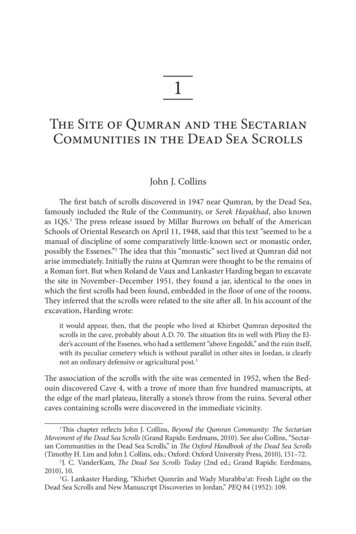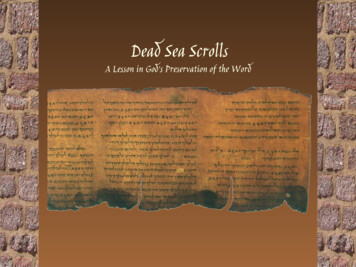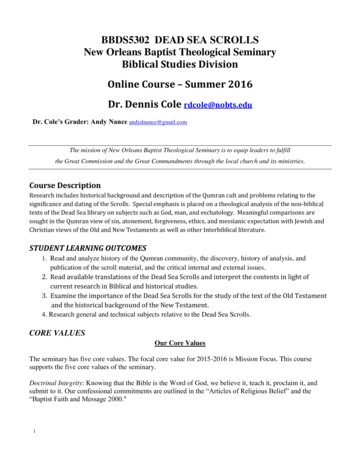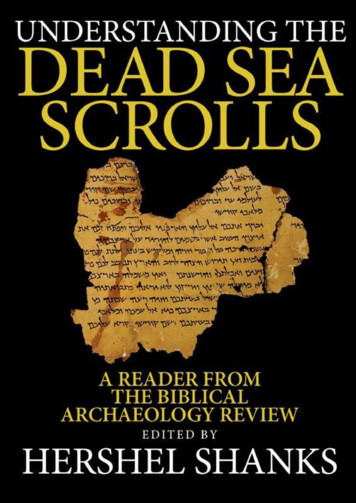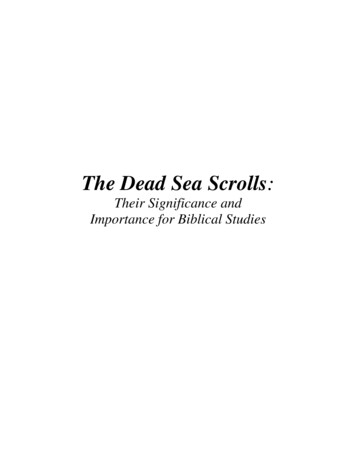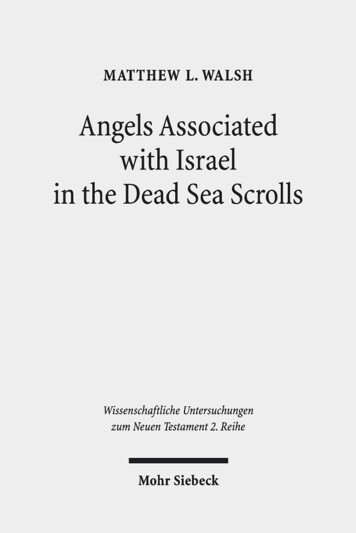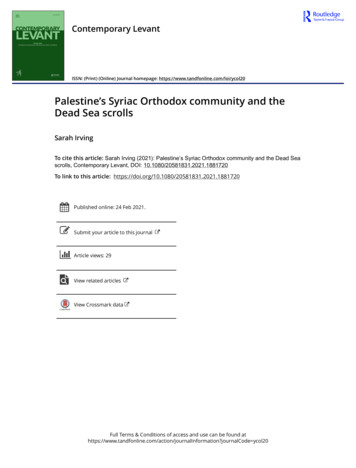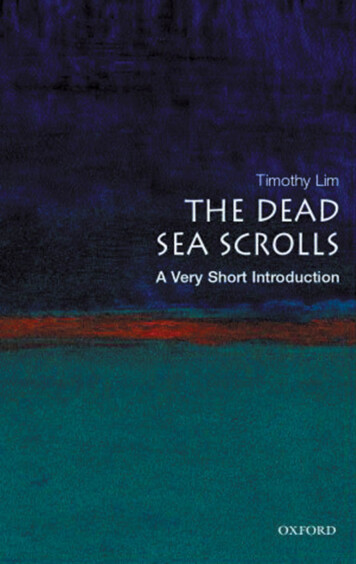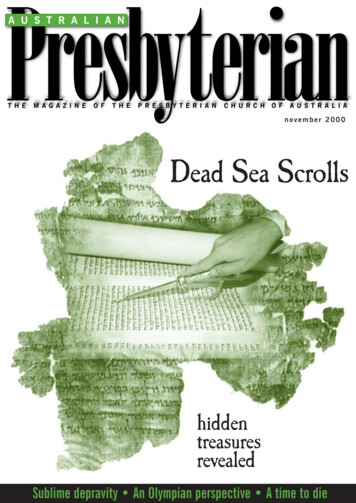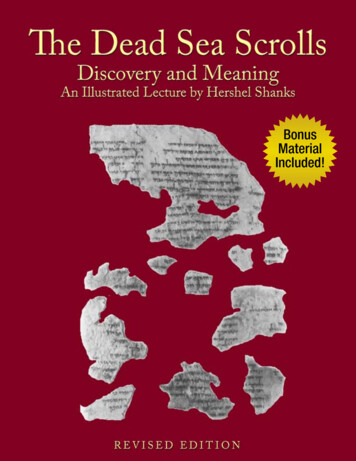
Transcription
turebyHershelShanksBonusMaterialIncluded!REVISED EDITION
The Dead Sea Scrolls—Discovery and MeaningHershel Shanks 2007 Biblical Archaeology Society3
About the Biblical Archaeology SocietyThe excitement of archaeology and thelatest in Bible scholarship since 1974The Biblical Archaeology Society (BAS) was founded in 1974 as a nonprofit, nondenominational,educational organization dedicated to the dissemination of information about archaeology in theBible lands.BAS educates the public about archaeology and the Bible through its bi-monthly magazine,Biblical Archaeology Review, an award-winning web site www.biblicalarchaeology.org, books andmultimedia products (DVDs, CD-ROMs and videos), tours and seminars. Our readers rely on usto present the latest that scholarship has to offer in a fair and accessible manner. BAS serves as animportant authority and as an invaluable source of reliable information.P ublishing E xcel lenceBAS’s flagship publication is Biblical Archaeology Review. BAR is the only magazine that connectsthe academic study of archaeology to a broad general audience eager to understand the world ofthe Bible. Covering both the Old and New Testaments, BAR presents the latest discoveries andcontroversies in archaeology with breathtaking photography and informative maps and diagrams. BAR’s writers are the top scholars, the leading researchers, the world-renowned experts.BAR is the only nonsectarian forum for the discussion of Biblical archaeology.BAS produced two other publications, Bible Review from 1985–2005, and Archaeology Odysseyfrom 1998–2006. The complete editorial contents of all three magazines are available on theBAS Online Archive. The Archive also contains the text of five highly-acclaimed books, AncientIsrael, Aspects of Monotheism, Feminist Approaches to the Bible, The Rise of Ancient Israel and TheSearch for Jesus. The online archive is available through various colleges, universities, churches,synagogues and other institutions.W i despread Ac c laimThe society, its magazine, and its founder and editor Hershel Shanks have been the subject ofwidespread acclaim and media attention in publications as diverse as Time, People, Civilization,U.S. News and World Report, The New York Times, The Washington Post and The Jerusalem Post. BAShas also been featured on television programs aired by CNN, PBS and the Discovery Channel.To learn more about the Biblical Archaeology Society and subscribe to its magazine, go towww.biblicalarchaeology.org. 2007 Biblical Archaeology Society4
ContentsPart I—The Complex History of the Dead Sea Scrolls . . . . . . . . . . . . . . . . . . . . . . . . . . . . . . . . . . . . . 8Part II—What Do the Scrolls Tell Us about Christianity?. . . . . . . . . . . . . . . . . . . . . . . . . . . . . . . . . . 15Part III—What Do the Scrolls Tell Us about the Hebrew Bible? . . . . . . . . . . . . . . . . . . . . . . . . . . . . 19Part IV—What Do the Scrolls Tell Us about Early Judaism? . . . . . . . . . . . . . . . . . . . . . . . . . . . . . . . 21Bonus Material—Spotlight on Non-Biblical Scrolls . . . . . . . . . . . . . . . . . . . . . . . . . . . . . . . . . . . . . . 24Photo Credits . . . . . . . . . . . . . . . . . . . . . . . . . . . . . . . . . . . . . . . . . . . . . . . . . . . . . . . . . . . . . . . . . . . . . . 31 2007 Biblical Archaeology Society5
The Dead Sea Scrolls—Discovery and MeaningHershel ShanksThe Dead Sea Scrolls have been called the greatest archaeological find of the 20th century. Andthey are. Everybody knows of the Dead Sea Scrolls. I was once in a taxi cab in Kansas City andthe driver had no idea that I was in any way connected with the Scrolls, and he raised the subject.Although everyone knows of the Dead Sea Scrolls, almost no one can tell you what they say.What do they really tell us? What do we know that we didn’t know before? That’s the questionthat I’m going to try to answer.In fact, I’m going to try to answer three questions:1. What do the Dead Sea Scrolls tell us about the development of Early Christianity?2. What do the Dead Sea Scrolls tell us about the Hebrew Bible?3. What do the Dead Sea Scrolls tell us about the history of Judaism?But before I do that, I would like take a trip with you to the site where the Dead Sea Scrollswere found, on the shores of the Dead Sea in the Judean Desert. 2007 Biblical Archaeology Society7
The Dead Sea Scrolls—Discovery and MeaningPar t I—T he Comple x Histor y of the Dead S ea S crol lsWe’re going to start from Jerusalem.This is a view of Jerusalem, which youcan hardly see because it’s on the topof a ridge. As we come down on theeast side of Jerusalem, we are in theJudean Desert. The rains that comefrom the Mediterranean rise up to thehighest ridge in the country and dropall of their water there. There is nowater left for the eastern side. Thisproduces the desert you see.This ridge is like a backbone up thecentral part of the country. If youwant to go north/south in the centralpart of the country, you really have tostick to this ridge. Otherwise, if you go to the east or to the west, you will be going up and downthese huge wadis (dry riverbeds), as you see in the picture.As we go further into the desert, we can stillsee Jerusalem receding on the ridge, with a herdof sheep in the foreground. Unfortunately yousee fewer and fewer sheep these days, and you’remore likely to see a Bedouin driving a truck thanriding a camel.Only 15 minutes from Jerusalem, youcome upon a monument marking sealevel. We’re halfway from the highestpoint in the country to the lowest point onthe face of the earth. And in another 15minutes we are at the Dead Sea itself. Unfortunately, you can no longer see the salt mounds thatyou see in this picture. The Dead Sea is recedingby 3 feet a year because too much water is beingsiphoned off before it gets to the Dead Sea. 2007 Biblical Archaeology Society8
The Dead Sea Scrolls—Discovery and MeaningThis view of the Dead Seashows a small coastal plaincovered with vegetation. Behind that plain, we see thelimestone cliffs. At a moresoutherly point on the shoreof the Dead Sea, the cliffs goall the way down to the water.There is not coastal plain.This is a closeup of the limestonecliffs, and you can see it’s pockmarked with caves. In one of thecaves pictured here, the first DeadSea Scrolls were found by twoBedouin.Here we are inside one of these caves. You might imagine that all you had to do to rescuethe Dead Sea Scrolls was to find them in a cave like this. But that’s not true. The scrolls themselves were often buried under ameter or more of debris and batguano. The ceilings of the caves hadoften caved in from seismic disturbances, burying the fragments stillfurther. This is in the Great Rift Valley, which goes all the way south toAfrica and north to Lebanon andSyria. There are frequent earthquakes, which have their effect onthe interior of caves like this. Theyare dark and smelly and generallyunpleasant. 2007 Biblical Archaeology Society9
The Dead Sea Scrolls—Discovery and MeaningThis cave overlooks the ruinsof Qumran and the Dead Sea.Beyond are the mountains ofMoab on the other side of theDead Sea, today modern Jordan.These are the two Bedouin,including Mohammad edh-Dhib (“The Wolf”), on the right, who are said tohave discovered the first seven intact scrollsfrom what has become known as Cave 1. Supposedly edh-Dhib was searching for a lostsheep; he threw a stone into a cave, thinkingthat the sheep might be in there and be scaredand come running out. But instead of bleatingsheep, he heard the cracking of pottery. Whenhe went in, he discovered pottery jars in whichwere some ancient scrolls.What happened then is obscure, butwhat we know is that in one way oranother the scrolls and, more importantly, the scrolls that would be subsequently discovered, found their way to aBethlehem antiquities dealer nicknamedKando. Kando was the middleman forthe Bedouin. 2007 Biblical Archaeology Society10
The Dead Sea Scrolls—Discovery and MeaningThree of the seven scrolls were acquired by the Israelis through a professor of archaeology at HebrewUniversity named Eleazer LipaSukenik, pictured here, who traveled to Bethlehem on a bus during avery violent time before the end ofthe British Mandate over Palestine—November 28, 1947. In BethlehemSukenik acquired three of the sevenDead Sea Scrolls, including a scrollof the book of the prophet Isaiah.When Sukenik returned to Jerusalem, with the three scrolls in apaper bag, the place was in pandemonium. The Jews were celebrating, singing and dancing in the streets because the United Nations had just voted by a two-thirdsvote for the partition of Palestine into a Jewish state and an Arab state, creating a Jewish republicfor the first time in 2,000 years. Sukenik saw that as almost messianic: to recover a 2,000-year-oldscroll, from the time the Jews last had their own state, on the same day that a Jewish state wasagain being created was a moving spiritual experience for Sukenik.The other four original scrolls came into the possession of the Metropolitan Samuel, the Syrian Christiancleric who led that community in Jerusalem. Heattempted to sell the scrolls, but when he couldn’t sellthem, he brought them to the United States in thehope of increasing their value and finding a buyerthere. They were displayed in the Library of Congress.But he still couldn’t sell them. So in desperation, theMetropolitan Samuel placed this ad in The Wall StreetJournal, advertising four Dead Sea Scrolls for sale. 2007 Biblical Archaeology Society11
The Dead Sea Scrolls—Discovery and MeaningAs it turned out, Sukenik’s son, the greatarchaeologist Yigael Yadin, was in theUnited States at the time. Someone pointedout to him the ad in The Wall Street Journal.Here is a picture of Yadin, with his baldhead, watching as another scholar tries topry apart some small fragments of ancientscrolls. Having seen the ad in The WallStreet Journal, Yadin made a clandestineeffort to purchase them. He was purchasing them on behalf of Israel, but he wasfearful that if the Metropolitan Samuelknew that he represented Israel the Metropolitan would not sell them to him. SoYadin used some fronts and in that waynegotiated the purchase—four intact DeadSea Scrolls for 250,000, which was anenormous bargain even then.Did the Metropolitan Samuel know thathe was selling them to Israel? I think hedid. The reason that he couldn’t easily sellthem to anyone else was that he couldn’tshow good title. Qumran was then controlled by Jordan, so Jordan had a claim, which it asserted, to title to the Dead Sea Scrolls. TheMetropolitan must have suspected that only Israel would buy them. Israel wouldn’t be concerned with that difficulty of getting good title. So Yadin purchased them on Israel’s behalf.The sale had an unfortunate consequence for the Metropolitan Samuel and his Syrian communityin the United States, who lived largely in New Jersey. The papers were badly drawn, and the UnitedStates sued the Metropolitan Samuel, claiming that the sale was a taxable transaction. Most of themoney from the sale of the four Scrolls went to the United States government.With the purchase by Yadin, allseven of the intact Dead Sea Scrollsfound by the Bedouin were now inIsraeli hands. A special museum,the Shrine of the Book, was built tohouse them. The architecture mimics certain aspects of the Scrolls.The white dome is shaped like thelid of the scroll jars in which thescrolls were found. The contrastbetween the black slab and thewhite dome is meant to echo theWars of the Sons of Light againstthe Sons of Darkness, the subject ofone of the scrolls. 2007 Biblical Archaeology Society12
The Dead Sea Scrolls—Discovery and MeaningWe have looked at pictures of the Dead Sea, of thecoastal plain and of the precipitous and almost uninhabitable limestone cliffs behind the plain. Butbetween the limestone cliffs and the small plain by thesea is a marl terrace of much softer rock. It is on thismarl terrace that Qumran was originally built. In thisaerial view we see the ruins of Qumran. The marl terrace sits beside a wadi, or a valley (nahal in Hebrew, wadi in Arabic) through which a day or twoa year the winter rains flow down to the sea. We see the wadi on one side of the picture, as wellas some finger-like protrusions of the marl terrace in which are caves. These are man-made cavesin which thousands of scroll fragments were found.This is the Wadi Qumran in the spring of theyear when the flowers areout. We are looking up atthose same fingers in themarl terrace. The holes atthe top of the fingers arethe caves, including thefamous Cave 4, whichhad more than 500 different scroll manuscripts init. Visitors are not allowedto go into Cave 4 today,but we were permitted,and here I am crawlingdown a hole in the top ofthe cave into Cave 4. 2007 Biblical Archaeology Society13
The Dead Sea Scrolls—Discovery and MeaningThis is the inside of Cave 4. It’s muchcleaned up since the days when it was excavated and the 500 manuscripts were foundin it. Incidentally, they were all in tiny fragments, not an intact scroll among them. Onetheory is that this was the library of the sect,an Essene library. You can see holes in thewall at various levels. It’s been suggestedthese were the fittings for shelves, whichwere placed around the cave and on whichthe scrolls were stored. Eventually theseshelves broke and the scrolls fell down andwere covered with debris and bat guano androcks from the earthquakes. By the time theywere found in the 20th century, they were allin small fragments, chewed on by rodents.This next photo shows you the condition inwhich these fragments came to the scholars—little bits and pieces, sometimes in cigar boxespurchased from the Bedouin through Kando.When the fragments were cleaned and placedunder glass, they looked like jigsaw puzzleswith 90 percent of the pieces missing, as wesee in this example.This is the complete Isaiah Scroll, which was foundin Cave 1 by the Bedouin and is known as Isaiah A. Itis open to Chapter 40, verse 3, which states, “A voicecries out in the wilderness: Prepare a way for theLord; make straight in the desert a highway for ourGod.” This passage is quoted in all three SynopticGospels, Mark, Matthew and Luke. 2007 Biblical Archaeology Society14
The Dead Sea Scrolls—Discovery and MeaningPa r t I I —W h a t D o t h e S c ro l l sTel l Us a b o u t C h r is t i a n i t y?Now that we’re all familiar with the site of Qumran, and the cliffs and the caveswhere the Dead Sea Scrolls were found, we can begin to answer the questions thatI posed at the outset.I’m going to give you the quick and simple answer to all three questions:what the scrolls tell us about Christianity, about the Hebrew Bible and aboutJudaism. And the simple, quick answer is that all of these questions must beanswered in the context of other questions of other scholarly disciplines. Inother words, there’s really nothing that you can point to in the Scrolls and say,“Aha, this is astounding! We didn’t know this before!” On the other hand, thereis almost no question that you can ask, beginning at about 300 B.C.E. to 300 C.E.,a six-hundred-year period, about which the scholar doesn’t have to ask, “Do theScrolls have anything to say about my question?” That’s what I mean by context.The scrolls are important and may be important in asking every conceivable kindof question in this 600-year period, from shortly before the earliest Scrolls werewritten, through the beginning of the rabbinic period of Judaism.Incidentally, this places a tremendous burden on scholars. Imagine a New Testament scholar who speaks Greek like you speak your mother tongue. He’s anexpert in the New Testament, and suddenly you tell him, “If you really want tounderstand this, go learn Hebrew and Aramaic and study the Dead Sea Scrollsto see if they have some bearing on the question you are asking.” So the first andbasic point I want to make is that the Scrolls become important in the context ofother questions.Now I’m going to consider a couple of representative questions in each of thethree categories that I mentioned, Christianity, Hebrew Bible and Judaism of thisperiod, to illustrate how the Dead Sea Scrolls are important to almost any question that you can ask in these areas.First, Christianity. I suppose that in a sense the Dead SeaThe Scrolls provide a contextScrolls do undermine a certain kind of what I might call a naïveforthe search for what scholarsChristian faith. I remember talking to a great Catholic Dead Seacall the Historical Jesus.Scroll scholar, Father Joseph Fitzmyer. He told me that the Scrollsare no threat to the “mature Christian.” But, in a sense, they doundermine what I call a naïve understanding of Christianity. It’sthe faith that believes that when Jesus came down he brought with him a newmessage that stunned his listeners—something unlike anything people had heardbefore. This view of Christian doctrine is really no longer valid. The scrollsdemonstrate very clearly the Jewish soil out of which Christianity grew. Not themessage, but the life of Jesus is unique and remains unique in history. But themessage has parallels; it has roots in Jewish history.So the Scrolls provide a context—you remember the word “context”—for thesearch for what scholars call the Historical Jesus. That’s a growing research area inmodern scholarship. And in the attempt to reach an understanding of the Historical Jesus, scholars paint very different pictures of the man. Some see him as aprophet, others see him as a revolutionary, and still others see him as a reformer. 2007 Biblical Archaeology Society15
The Dead Sea Scrolls—Discovery and MeaningSome see him as a rabbi. Another prominent scholar sees him as a Cynic philosopher. So there are different portraits of Jesus, but they all agree on one thing: Thathe was thoroughly Jewish. All scholars agree that he lived his life here on Earthas a Jew. It was not just incidental that Jesus happened to be born Jewish. If youwant to know about Jesus, you have to know about the Jewishworld in which he lived. And that’s where the Dead Sea ScrollsWhat does it mean to become in. The Dead Sea Scrolls provide the Jewish context ofthe Son of God? Theearly Christianity.Egyptian Pharaohs wereLet’s see if we can be more specific. I’m going to turn now to adeified as the sons of God. Dead Sea Scroll fragment. Almost all the Dead Sea Scrolls wereThe kings of Israel werefragmentary; not more than a dozen are intact in any sense ofalso the sons of God.the word. I’m going to talk about one of the fragmentary scrollsthat has a very sexy name: It’s called 4Q246. If that’s too hard toremember, you can think of it as the Aramaic Apocalypse.4Q246 or the Aramaic Apocalypse provides the context for a scholarly examination of the concept of the Son of God. 4Q246 says:Affliction will come on Earth . . . He will be called great . . . ‘Son of God’ he will becalled and ‘Son of the Most High’ they will call him . . . His kingdom will be aneverlasting kingdom . . . He will judge the Earth in truth and all will make peace.This was written a hundred years before Jesus was born. Luke 1:34-35, the famousAnnunciation scene in which the angel Gabriel tells Mary that she will bear a son,reads as follows:He will be great and will be called the Son of the Most High . . . of his kingdomthere will be no end . . . he will be called the Son of God.I don’t want any one to jump to conclusions. It’s most unlikely that Lukecopied the Dead Sea Scrolls; rather they both came out of the same Jewish soil. Inshort, the Dead Sea Scrolls help us to understand the Jewish context out of whichChristianity grew.Let’s talk about the Son of God for a minute. What does it mean to be the Son ofGod? Again, you have to look at the Jewish context. The Egyptian Pharaohs weredeified as the sons of God. The Roman emperors were deified as the son of God.And now I’ll tell you something that may surprise you. The kings of Israel werealso the sons of God. In Psalm 2:7, the Lord tells the king, “You are my son/TodayI have begotten you.”It’s very important that we focus on the word “Today I have begotten you.” Theword is ha-Yom in Hebrew. The king of Israel became the son of God when he wasinstalled as king. Scholars call this the Adoptionist Theory. In this sense of theconcept of son of God, the king was not born the son of God but was adopted asthe Lord’s son when he became king. There are other sources in the Hebrew Biblein which the king is referred to as the son of God. For example, in 2 Samuel 7:14,the Lord says to King David through the prophet Nathan, “I will be a father tohim, and he shall be a son to me.”In another context, all of Israel is the son of God. Look at Psalms 89:26: “You aremy father, my God, the rock of my salvation.” Or look at Hosea 11:1, “When Israelwas a child, I loved him, and out of Egypt I called my son.” 2007 Biblical Archaeology Society16
The Dead Sea Scrolls—Discovery and MeaningYou may say that these are figurative uses of the concept of son of God; they’renot literal, you may say, as in the New Testament. Well, yes and no. There aresome differences, but there are also some similarities. As a matter of fact, in theNew Testament itself, we see a development of the concept of the son of God. Forexample, Paul, whose letters are the earliest documents of the New Testament,knows nothing of the virgin birth. In Paul, Jesus becomes the son of God at hisresurrection. Read Paul’s letter to the Romans, where Jesus was “declared to bethe son of God, with power according to the spirit of holiness by resurrection of thedead” (Romans 1:3-4).This comes very close to the Adoptionist Theory that we saw in the HebrewBible. This same concept is reflected in the Book of Acts, where Jesus becomes theson of God as a result of his resurrection. In Acts 13:32-33, Paul declares after theresurrection, “What God has promised to our ancestors he has fulfilled for us . . .by raising Jesus.” Then Paul quotes Psalms 2:7, mentioned above, in which theLord calls the king of Israel his son, and says, “Today I have begotten you.” In thistext from Acts, Jesus becomes the son of God “today”—when he is resurrected.Elsewhere in the New Testament, however, Jesus becomes the son of God at anearlier point. Instead of becoming the son of God at his resurrection, he becomesthe son of God at his baptism in the Jordan River by John the Baptist, which, incidentally, occurred a stone’s throw from where the Dead Sea Scrolls were found.As the New Testament recounts in the Gospels of Matthew3:17, Mark 1:11 and Luke 3:22, a voice from heaven proclaims atYou don’t have to be a scholarJesus’ baptism, “You are my beloved son.” According to someto see that this language isversions of these Gospel passages, the text then quotes the pasvery similar to the Beatitudessage of Psalms 2:7: “Today I have begotten you.” Jesus becomesin Matthew’s Sermon on thethe son of God at an earlier stage, not at the Resurrection, but atMount and in Luke’shis baptism.Sermon on the Plain.Finally, in the Infancy Narratives in Matthew and Luke, Jesus’status as the son of God is pushed back to his conception. Thisdoesn’t mean, however, that divine sperm was somehow inserted into Mary.What divine sonship really means is that Jesus had a special relationship to Godfrom the very beginning, and it suggests that these Infancy Narratives are notintended to be taken literally. Otherwise, why would the Gospels trace Jesus’ lineage to King David through Joseph?Let’s look at another central concept of Christianity and see how the Dead SeaScrolls help us to understand the Jewish concept of the Messiah, Moshiach inHebrew. Another fragmentary Dead Sea Scroll, called 4Q521, says, “The heavensand earth will listen to his Messiah . . . Over the poor his spirit will hover and willrenew the faithful . . . He . . . liberates the captives, restores sight to the blind,strengthens the bent [compare Psalms 146:7-8] . . . He will heal the wounded andrevive the dead and bring news to the poor [compare Isaiah 35:5-6; 61:1].”You don’t have to be a scholar to see that this language is very similar to theBeatitudes in Matthew’s Sermon on the Mount and in Luke’s Sermon on thePlain: “The blind receive their sight and the lame will walk, lepers are cleansedand the deaf hear, and the dead are raised up and the poor have good newspreached to them” (Matthew 11:5/Luke 7:22). 2007 Biblical Archaeology Society17
The Dead Sea Scrolls—Discovery and MeaningIf we want to plumb the original understanding of the Christian messiah, wemust look at the Jewish understanding of the concept from which the Christianconcept developed. Moshiach in Hebrew literally means “anointed.” Kings andpriests were anointed in their office by having oil poured on them. At that timethey became the Moshiach, the anointed one, the messiah. The word had no otherworldly connotations originally. After the Babylonian destruction of Jerusalemand the Temple of Solomon in 586 B.C.E., the concept of Messiah, or Moshiach,became attached to the idea of the restoration of the Davidic dynasty, which hadlasted for 400 years but which had ended with this devastating defeat. The ideathat the Messiah would return as a descendant of King David is reflected in theChristian tradition mentioned earlier, which sees Jesus as being a descendant ofDavid (incidentally, through his father Joseph).Some scholars believe that this is what lies behind Jesus’ birth in Bethlehem.Many scholars believe that Jesus was actually born in Nazareth. He was alwayscalled Jesus of Nazareth, never Jesus of Bethlehem. Other scholars, however,maintain that he was in fact born in Bethlehem. But those who say he was born inNazareth are faced with the question, why does the story tell us that he was bornin Bethlehem? The answer that they give is that Bethlehem was where David wasborn and Jesus, the messiah in the Davidic sense of the word, will be a scion ofDavid and come from the town that David came from.When in Jewish history the Davidic Messiah never appeared and the return topolitical independence seemed but a dream, the idea of the Messiah changed. Itbecame a kind of spiritual messiah and an apocalyptic messiah who will come torule at the end of time and relieve Israel’s troubles. It is in this later developmentof the Jewish concept of Moshiach, the Messiah, that we must understand thenature of Jesus’ messiahship.There are many other similarities between Christianity and the Judaism ofJesus’ time and earlier. I’ve already mentioned the Beatitudes. The way that theQumran sectarians, the Essenes perhaps, interpret scripture isvery much the way the New Testament interprets HebrewIf we want to plumb theoriginal understanding of the Scriptures. Both apply words of the ancient Hebrew text to theChristian messiah, we must present-day, as if the Hebrew writer were speaking of the fulfillment of the Hebrew scripture at the time that the interpreterlook at the Jewishunderstanding of the concept lived. The idea of the coming of the end of time, the dualism ofthe sons of light and the sons of darkness, the communal meals,from which the Christianthe importance of bread and wine—all these aspects of earlyconcept developed.Christianity are also to be found in the Dead Sea Scrolls.There are more than 900 different manuscripts that have beenfound in Qumran. Almost all are very fragmentary. Of the 900, more than 200 aremanuscripts of the Hebrew Bible, so obviously there is more than one copy ofmany of the texts. The three most popular books are the Book of Psalms, the Bookof Deuteronomy and the Book of Isaiah. Thirty-nine copies of the Book of Psalmshave been found among the Dead Sea Scrolls, 36 copies of the Book of Deuteronomy and 22 copies of Isaiah. Interestingly, these are the three most frequentlyquoted books in the New Testament; the most important books to the Qumran 2007 Biblical Archaeology Society18
The Dead Sea Scrolls—Discovery and Meaningsectarians were apparently the most important books to the writers of the NewTestament as well.I don’t mean to imply that there is any direct link between the Dead Sea Scrollsand Christianity. The Dead Sea Scroll sectarians were not early Christians. I’vecalled attention to many similarities, but there are also many differences. TheQumran sectarians placed heavy stress on the Law, especially the purity laws.They were rigorous in their observance. It’s easy to exaggerate the similaritiesbetween the Qumran sectarians and the early Christians. There is no direct link.Par t I I I —W h a t D o t h e S crol lsTe l l Us a b o u t t h e H e b re w B i b l e ?Now I’ll try to answer the second question raised at the outset: How do the DeadSea Scrolls help us to understand the Hebrew Bible?As noted earlier, more than 200 Biblical manuscripts have been discovered atQumran. They include every book of the Hebrew Bible except Esther and Songsof Songs (although there may have been a kind of version of Esther). But to talkabout the Hebrew Bible is in a sense anachronistic. This was at a time before theHebrew Bible. At this point in history there was no fixed canon, no authoritativelist of sacred books. There was Torah (the Five Books of Moses), there were prophetic works, there were other works that became part of the Bible later and othervery similar books that did not. For example, books like Jubilees,Enoch, the Temple Scroll, Judith, Tobit and Ecclesiasticus nevermade the final cut. They were rejected as canonical texts. Some To talk about the Hebrew Bibleof them were included in what became the Catholic Bible and is in a sense anachronistic. Thiswas at a time before theare known as the Apocrypha (or Deutero-canonical). On theHebrew Bible.other hand, the Song of Songs, Ecclesiastes and Daniel did makethe final cut and were included in what was to become theHebrew Bible.But there is an
The Dead Sea Scrolls have been called the greatest archaeological find of the 20th century. And they are. Everybody knows of the Dead Sea Scrolls. I was once in a taxi cab in Kansas City and the driver had no idea that I was in any way connected with the Scrolls, and he raised the subject.
